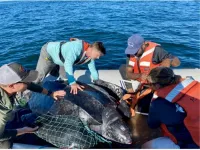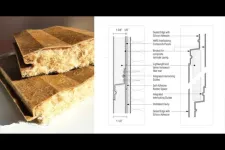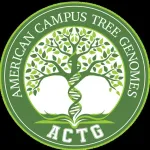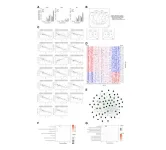(Press-News.org) The Damon Runyon Cancer Research Foundation has named 14 new Damon Runyon Fellows, exceptional postdoctoral scientists conducting basic and translational cancer research in the laboratories of leading senior investigators. The prestigious, four-year Fellowship encourages the nation's most promising young scientists to pursue careers in cancer research by providing them with independent funding ($300,000 total) to investigate cancer causes, mechanisms, therapies, and prevention.
The Foundation has also named six recipients of the Damon Runyon-Dale F. Frey Award for Breakthrough Scientists. This award recognizes Damon Runyon Fellows who have exceeded the Foundation’s highest expectations and are most likely to make paradigm-shifting breakthroughs that transform the way we prevent, diagnose, and treat cancer. To catapult their research careers—and their impact—Damon Runyon makes an additional investment of $100,000 in these exceptional individuals.
“Getting the Breakthrough Scientist Award was so helpful in that transition period from being in someone else’s lab to starting my own lab,” said 2020 Dale F. Frey Awardee Lindsay B. Case, PhD, now an Assistant Professor of Biology at MIT. “Damon Runyon not only solidified that my ideas were exciting but also gave other funding agencies confidence to fund me. It was really the seed that has grown my research program over the last few years.”
2024 Recipients of the Damon Runyon-Dale F. Frey Award for Breakthrough Scientists
Zibo Chen, PhD, Westlake University, Hangzhou
“Protein-based molecular programming for cancer immunotherapy”
An ideal cancer therapeutic should be able to selectively target the activity of key cellular pathways that support or drive growth in cancer cells. It should also elicit downstream actions, such as recruiting T cells for cancer cell killing. Since most of the signaling inside cells is facilitated by proteins, a promising new direction for cancer therapy involves building modular and programmable circuits inside living cells using lab-designed proteins. Dr. Chen aims to combine cutting-edge methods in computational protein design and synthetic biology to build a protein-based circuit that can sense multiple inputs (e.g., cancer biomarkers) and carry out a diverse set of functions (e.g., cancer cell killing) based on pre-programmed instructions.
Junhong Choi, PhD, Memorial Sloan Kettering Cancer Center
“Uncovering cell-fate decision via molecular recording”
Both normal cells and cancer cells can follow various pathways rather than a specific sequence of events during their development. Understanding how these different pathways influence the final state of a cell is crucial for comprehending cell development, especially in the context of cancer. In cancer development, specific pathways leading to the formation of aggressive cancer cells can be identified and targeted for treatment or prevention. Dr. Choi’s research focuses on the development of tools, collectively known as molecular recording, to observe the past pathways each cell took to reach its current state. This is achieved by equipping each cell with the ability to store information about its past events in its genome, essentially recording its history in its DNA for later retrieval. Dr. Choi’s goal is to apply these technologies to various cancer models, revealing how the developmental path of cancer cells influences their current and future ability to invade and proliferate in specific locations within the human body.
Rachel Segal Greenberg, PhD, Harvard Medical School, Boston
“The function of interoceptive circuits in reproduction and cancer”
Interoceptive neural circuits are responsible for sensing internal changes in the body and initiating appropriate responses. In the context of female reproduction, these neurons sense internal states within the reproductive tract and maintain homeostasis by modulating functions like smooth muscle contractions, fluid flow, and communication with the central nervous system. The female reproductive tract undergoes major changes throughout life, ranging from pregnancy to gynecological cancers like high-grade ovarian carcinoma. Dr. Greenberg is investigating how interoceptive neurons monitor the female reproductive tract and modulate essential physiologies in these changing hormonal and biological states. Her research on the typical functions of reproductive neurons and on the neuronal contribution to tumor progression may suggest novel therapeutic approaches for gynecological cancer treatment.
Julia Su Zhou Li, PhD, University of California, San Diego
“Uncovering the link between repetitive DNA, genomic instability, and tumor viruses”
Dr. Li’s research aims to uncover a missing link between repeated DNA sequences, genomic instability, and viruses. While abnormal expansion of “repeats” has been found at unstable genomic regions, known as fragile sites, that are implicated in cancer growth, the mechanisms and consequences of this genomic instability remain poorly understood. Dr. Li recently discovered a cluster of Epstein Barr Virus (EBV)-like repeat sequences in the genome that breaks when bound by abnormally high levels of EBV antigens. These findings illustrate how a chromosome can be broken in long-term EBV infection, which can threaten genome stability and trigger cancer development. Dr. Li aims to leverage this discovery to advance our understanding of how broken repeats threaten genome integrity for clinical screening of individuals susceptible to EBV-associated diseases, and for the prevention and treatment of disease in these individuals. This research could also lead to the discovery of other virus-like repeats and the potential biological function of these virus-like repeats in our genome.
Jingchuan Luo, PhD, Whitehead Institute for Biomedical Research, Cambridge
“Decoding the role of localized translation in normal physiology and cancer metastasis”
Metastatic cancers exploit cellular machinery to increase their proliferative potential and direct invasive cell migration. Specifically, cancer cells can adjust the translation of RNA into proteins to keep up with the demands of growth and metastasis. An important way that cells fine-tune their translation and quickly modulate cellular responses is through localized translation, or the translation of proteins in other areas of the cell further from the nucleus. To study the scope of localized translation, Dr. Luo has developed a highly sensitive, spatially-specific, and optically-controlled technique, which enables the quantification of translation at any given subcellular location. She will focus on understanding mechanisms of localized translation by identifying which genes are locally translated, how they are regulated, and why this process is important. Understanding the molecular mechanism of local protein synthesis could yield invaluable insights into the basis of cancer metastasis and inform therapeutic strategies.
Mark R. Sullivan, PhD, Harvard T.H. Chan School of Public Health, Cambridge
“Identifying determinants of pathogenesis and drug resistance in opportunistic lung infection”
Many types of cancer, chemotherapy, and numerous other underlying conditions can leave patients vulnerable to infection by bacteria that would normally be unable to survive in the body. These opportunistic infections are challenging to treat, as antibiotics are often ineffective against these pathogens or have serious side effects not well-tolerated by individuals with underlying conditions. Dr. Sullivan studies how opportunistic infections occur, with a particular focus on lung infection. His ongoing work is centered on identifying bacterial adaptations that enable pathogens to survive both the host defense systems present in the lung as well as antibiotic treatment. His work will help deepen our understanding of opportunistic infection and may provide novel avenues for more effective and tolerable treatment of these pathogens.
November 2023 Damon Runyon Fellows
Kheewoong Baek, PhD, with his sponsor Eric S. Fischer, PhD, at Dana-Farber Cancer Institute, Boston
Attaching a small molecule known as ubiquitin to a protein, in a process called ubiquitylation, targets that protein for degradation. By utilizing the ubiquitylation machinery, scientists are now able to target cancer-causing proteins for degradation, a strategy that has proven effective with drugs such as Lenalidomide/Revlimid to treat multiple myeloma. One way to bring proteins in proximity to ubiquitin ligases (attachers) is with synthetic adhesion molecules, or “molecular glue.” This may provide a means of targeting proteins previously deemed undruggable, including those that lack a binding site for inhibitors. Dr. Baek aims to expand the degradable proteome by establishing a formula for the design of molecular glues to target cancer-causing proteins as a therapeutic modality. Dr. Baek received his PhD from Technical University of Munich and Max Planck Institute of Biochemistry, Munich, his MS from University of Tennessee Health Science Center, Memphis, and his BA from Rutgers University, New Brunswick.
Sagar Bhattacharya, PhD [Connie and Bob Lurie Fellow], with his sponsor William F. DeGrado, PhD, at University of California, San Francisco
Peptide drugs, which mimic the function of natural peptides such as hormones or growth factors, have emerged as a promising strategy for the treatment of cancer. Despite their potential, however, very few have reached the clinic in the past decade, primarily due to their off-target toxicity. The design of a suitable system to deliver peptides in a site-specific manner would address a major challenge in the development of anticancer peptide drugs. De novo protein design, or building proteins “from scratch,” has allowed for the engineering of functional proteins for a broad range of applications, from catalysis to pharmaceuticals. Dr. Bhattacharya aims to design proteins from scratch that can “mask” a peptide of interest for systemic delivery to the desired location. This project will initially target pediatric sarcomas, but eventually extend to other cancers like glioblastoma and breast cancer. Dr. Bhattacharya received his PhD from Syracuse University, Syracuse and his MS and BS from University of Calcutta, Kolkata.
Laura Crowley, PhD [HHMI Fellow], with her sponsor Mark A. Krasnow, MD, PhD, at Stanford University, Stanford
Fibroblasts are one of the earliest known cell types and they contribute to many of the most burdensome lung diseases, including cancers, fibrosis, and emphysema; however, they are surprisingly poorly understood. Dr. Crowley will examine the different types of fibroblasts in the mouse lung to determine where they come from and how they function normally, as well as how they change with injury and disease. This will establish an important baseline for how these cells function in mice and also provide critical, long-term insights into how these cells may function in humans, where lung diseases are very difficult to treat and are among the leading causes of mortality worldwide. Though her work will directly analyze the fibroblasts and microenvironment around lung tumors, her findings could translate to many other solid tumor contexts. Dr. Crowley received her PhD from Columbia University, New York and her BA from Colby College, Waterville.
Antonio Cuevas-Navarro, PhD [Berger Foundation Fellow], with his sponsor Piro Lito, MD, PhD, at Memorial Sloan Kettering Cancer Center, New York
Dr. Cuevas-Navarro’s research project focuses on targeting mutations in the RAS genes (HRAS, NRAS, and KRAS), present in about 30% of cancer patients and notorious for driving aggressive tumor growth. Dr. Cuevas-Navarro aims to mitigate these mutations’ effects by using pharmacological agents to enhance a biochemical process that regulates RAS proteins. His project will investigate the mechanism of action of these compounds and assess their effectiveness in patient-derived cancer models. This research has the potential to expand treatment options across various cancer types, including those where current treatments are limited. Dr. Cuevas-Navarro received his PhD from University of California, San Francisco and his BS from University of California, Davis.
John Devany, PhD [Bakewell Foundation Fellow], with his sponsor Jaehyuk Choi, MD, PhD, at Northwestern University, Chicago
T cell therapies have led to promising results in treating blood cancers, but new approaches are required to translate these results to solid tumors. In solid tumors, T cells face unique challenges in the tumor microenvironment (TME), which limits the persistence and efficacy of adoptive T cell therapies. In T cell lymphomas (TCLs), tumor cells overcome many of the same challenges through acquired mutations. Fueled by natural selection, tumor mutations produce novel and elegant solutions to address T cell deficits in the TME. Understanding that these modifications may be superior to current bioengineering capabilities, Dr. Devany plans to introduce gain-of-function mutations into therapeutic T cells to grant them the ability to survive, proliferate, and function in the TME. He will determine how each mutation restores different aspects of T cell function, allowing for the design of combinations of mutations that act synergistically. His results will aid in the development of next-generation T cell therapies to cure solid tumors. Dr. Devany received his PhD from University of Chicago, Chicago and his BS from University of California, Santa Barbara.
Brendan Floyd, PhD [HHMI Fellow], with his sponsor Carolyn R. Bertozzi, PhD, at Stanford University
Proteins found on the surface of cells are key agents in cancer progression, as they play a role in cell signaling and metastasis. Targeted protein degradation has emerged as a therapeutic strategy to modulate what are considered “undruggable” proteins. Specifically, lysosomal-targeting protein degradation (LTPD), which uses the cancer cell’s own degradation machinery to break down proteins, has demonstrated therapeutic potential. However, the proteins targeted for LTPD have been limited to a few well-studied membrane and extracellular proteins, leaving much still unknown about the breadth of proteins that can be targeted for degradation and the features of a target protein that determine LTPD efficacy. Dr. Floyd aims to systematically characterize the features of cell surface proteins that drive the efficacy of LTPD with the goal of identifying new targets for blood cancer treatment. Dr. Floyd received his PhD from University of Texas at Austin, Austin and his BS from California Polytechnic State University, San Luis Obispo.
Brooke D. Huisman, PhD, with her sponsors Diane J. Mathis, PhD, and Christophe O. Benoist, MD, PhD, at Harvard Medical School, Boston
To prevent autoimmune attacks, T cells are screened in the thymus to ensure they do not react to self-derived antigens. Dr. Huisman studies the thymus and, specifically, a population of cells called “thymic mimetic cells” that mimic other tissues, such as muscle or gut, and assist T cells in developing tolerance to diverse cell types. Dr. Huisman’s research focuses on understanding how thymic mimetic cells develop. This work may lead to improved understanding of thymus-mediated tolerance to tumors, novel therapeutic opportunities for manipulating mimetic cells to induce anti-tumor responses, and increased understanding of thymic tumors. Dr. Huisman received her PhD from Massachusetts Institute of Technology, Cambridge and her BS from University of Michigan, Ann Arbor.
Jordan B. Jastrab, MD, PhD [Robert Black Fellow], with his sponsor Jonathan C. Kagan, PhD, at Brigham and Women’s Hospital, Boston
Immune cells called macrophages can swallow bacteria and contain them in membrane-bound compartments called phagosomes. From inside the phagosome, some bacteria stimulate immune pathways in the cytosol, but it is unclear how immune signals are transmitted across the membrane from the phagosome into the cytosol. To investigate, Dr. Jastrab has developed a macrophage infection model using mutants of the bacterium Staphylococcus aureus that stimulate an immune complex in the cytosol called the inflammasome. He aims to identify the host and microbial pathways that facilitate activation of the inflammasome during infection. Because the activation of cytosolic immune receptors by phagosomal bacteria may be important in protection against colorectal cancer, Dr. Jastrab’s work aims to elucidate pathways that may be manipulated to prevent tumorigenesis and enhance anti-tumor immunity. Dr. Jastrab received his MD, PhD from New York University School of Medicine, New York and his BS from Tufts University, Medford.
Tamar Kavlashvili, PhD [Timmerman Traverse Fellow], with her sponsor Agnel Sfeir, PhD, at Memorial Sloan Kettering Cancer Center, New York
Mitochondria harbor independent genetic material known as mitochondrial DNA (mtDNA). This compact, circular molecule encodes proteins essential for the assembly of the mitochondrial electron transport chain to generate energy in form of ATP. Like nuclear DNA, mtDNA is susceptible to damage and mutations. One of the most common disease-causing aberrations of mtDNA is termed “common deletion.” This aberration disrupts mitochondrial function, resulting in neuromuscular diseases and potentially certain cancers, including colorectal cancer. Due to a lack of tools to modify the mitochondrial genome, researchers currently do not understand the mechanisms behind common deletion. Dr. Kavlashvili aims to investigate by using cutting-edge molecular biology tools to edit and visualize mtDNA genomes. She will then be poised to unravel impacts of this deletion on various tissues, in order to ultimately mitigate its pathological impact. Dr. Kavlashvili received her PhD from Vanderbilt University, Nashville and her BS from University of Iowa, Iowa City.
Shreoshi Sengupta, PhD, with her sponsor Carla F. Kim, PhD at Boston Children’s Hospital, Boston
Studies have shown that lung tumors are sustained through the formation of new blood vessels from pre-existing ones in a process called angiogenesis. Moreover, tumor cells secrete signaling proteins that help them communicate with each other and evade immune detection. However, most of these studies have been on late-stage lung tumors; our understanding of cell-cell interactions in the tumor environment during lung cancer initiation and early stages remains poor. Dr. Sengupta plans to identify the gene expression patterns in tumor cells, endothelial cells (blood-vessel-forming cells), and immune cells over time to understand how they engage in this cellular crosstalk, promoting tumorigenesis. She also plans to examine cell-cell interactions in early-stage lung cancer using organoids, or artificially grown miniature organs. This line of investigation will help understand the mechanisms underlying tumor initiation and lead to novel biomarkers that can help detect lung cancers earlier. The findings will also help identify novel therapeutic targets that can be inhibited to improve patient responses and survival. Dr. Sengupta received her PhD from Indian Institute of Science, Bangalore and her MS and BS from University of Calcutta, Kolkata.
James C. Taggart, PhD, with his sponsors Allon M. Klein, PhD, and Johan Paulsson, PhD, at Harvard Medical School, Boston
Antimicrobial resistance is a growing crisis that imperils our ability to protect patients immunocompromised by cancer treatment. Despite this, the few new antibiotics currently in clinical trials primarily use established mechanisms of action. Identification of new targets for antimicrobial drugs is thus an urgent clinical need. Recent work has shown that bacteria can tolerate substantial inhibition of many proteins thought to be essential for growth, rendering them poor drug targets. The mechanisms that cause this robustness are poorly understood. By combining cutting-edge microfluidic technologies with methods for controlled gene repression, Dr. Taggart will systematically identify mechanisms that allow bacterial cells to tolerate inhibition of genes critical for cellular growth. This work will guide the selection of targets for future antibiotic development and may reveal mechanisms by which to sensitize bacterial cells to existing drugs. Dr. Taggart received his PhD from Massachusetts Institute of Technology, Cambridge and his BS from Haverford College, Haverford.
Xianfeng Zeng, PhD, with his sponsor Michael A. Fischbach, PhD, at Stanford University, Stanford
Emerging evidence underscores the profound impact of the gut microbiome, a collection of microorganisms within our digestive system, on cancer. These microorganisms collectively generate various metabolites that can significantly influence cancer progression and treatment outcomes. Dr. Zeng is employing synthetic communities and mouse cancer models to delve into the intricate connections between cancer and the microbiome. His synthetic communities, comprised of over 100 strains, allow for precise manipulation of the microbiome to elucidate the role of specific microbial metabolites in cancer. Additionally, Dr. Zeng is studying community-scale metabolism and using genetically edited strains to design synthetic communities with desired metabolic profiles. These approaches will gain valuable insights into microbiome-cancer interactions and establish a broadly applicable strategy to harness the therapeutic potential of gut microbiome. Dr. Zeng received his PhD from Princeton University, Princeton and his BS from Tsinghua University, Beijing.
Pu Zhang, PhD, with his sponsor Omar Abdel-Wahab, MD, at Memorial Sloan Kettering Cancer Center, New York
Dr. Zhang is studying a unique three-stranded nucleic acid structure, called an R-loop, to understand its role in cancer development and find ways to target and control its formation. R-loops consist of a DNA-RNA hybrid and a displaced strand of DNA. R-loops occur frequently in human genomes, and while they play an important role in blood cell differentiation and immune cell function, they can also interfere with DNA repair and promote genome instability, giving rise to leukemia. However, the dynamic nature of R-loop formation hampers the detection of this structure in a small cell sample. To address this challenge, Dr. Zhang is developing novel techniques to map R-loops in normal blood stem cells versus blood cancer cells at single-cell resolution. He also plans to investigate leukemia-specific R-loops in vitro and in vivo with CRISPR-based screening techniques. The goal of his research is to aid development of therapeutic interventions for R-loop-related gene expression dysregulation in cancer, especially leukemia. Dr. Zhang received his PhD from Ohio State University, Columbus, his MS from University of Edinburgh, Edinburgh, and his BS from Chongqing University, Chongqing.
Shaohua Zhang, PhD [Timmerman Traverse Fellow], with his sponsor Wendell A. Lim, PhD at University of California, San Francisco
Dr. Zhang aims to engineer T cells with synthetic cell adhesion molecules (synCAMs) to augment current approaches for immunotherapy. This project represents a fundamentally new strategy for CAR T cell engineering that could overcome tumor escape from immunotherapy across multiple forms of cancer. Understanding how synCAMs contribute to CAR T cell efficacy will provide insights beyond cytotoxic CAR T cell therapy; this work could lead to the application of synCAMs in other engineered immune cell therapies under investigation, such as CAR macrophages, CAR natural killer cells, and CAR T regulatory cells. Overall, this approach could lead to CAR T cells that are much more robust to tumor evasion and target antigen expression, and thus much more effective therapeutically. Dr. Zhang received his PhD from University of Chinese Academy of Sciences, Shanghai and his BS from Wuhan University, Wuhan.
***
Damon Runyon Cancer Research Foundation
To accelerate breakthroughs, the Damon Runyon Cancer Research Foundation provides today's best young scientists with funding to pursue innovative research. The Foundation has gained worldwide prominence in cancer research by identifying outstanding researchers and physician-scientists. Thirteen scientists supported by the Foundation have received the Nobel Prize, and others are heads of cancer centers and leaders of renowned research programs. Each of its award programs is extremely competitive, with less than 10% of applications funded. Since our founding in 1946, in partnership with donors across the nation, the Damon Runyon Cancer Research Foundation has invested nearly $450 million and funded nearly 4,000 scientists.
100% of all donations to the Foundation are used to support scientific research. Administrative and fundraising costs are paid with revenue from the Damon Runyon Broadway Tickets Service and our endowment.
For more information visit damonrunyon.org.
END
Damon Runyon Cancer Research Foundation awards $4.8 million to top young scientists
2024-03-15
ELSE PRESS RELEASES FROM THIS DATE:
Groundbreaking study reveals extensive leatherback turtle activity along U.S. coastline
2024-03-15
A new study led by a team of marine scientists at the University of Miami Rosenstiel School of Marine, Atmospheric and Earth Science and the National Oceanic and Atmospheric Administration Southeast Fisheries Science Center, provides groundbreaking findings that offer insights on the migration and foraging patterns of leatherback sea turtles along the Northwest Atlantic shelf.
Scientists have known that leatherbacks commonly swim from the South and Mid-Atlantic Bights during the warmer months to reach feeding areas near New England and Nova Scotia, Canada where food is plentiful. ...
Imaging with 99mTc-maraciclatide correlates with identification of early-stage endometriosis by laparoscopic surgery
2024-03-15
The presentation summarised the preliminary findings from patients with known or suspected endometriosis who were imaged with a SPECT-CT camera and subsequently underwent planned laparoscopic surgery, a key-hole surgical procedure to establish the presence, absence and location of endometriotic lesions. The imaging findings were compared to the surgical and histology reports and indicate that 99mTc-maraciclatide holds potential as a non-invasive test for early-stage endometriosis.
Specifically these preliminary findings demonstrate that 99mTc-maraciclatide has the potential to:
Visualise superficial peritoneal endometriosis which is found ...
BU researchers first to identify a signaling molecule in neuroblastoma immunosuppression and aggressiveness
2024-03-15
(Boston)—The MYCN oncoprotein (proteins related to the growth of cancer cells) plays a key role in starting, advancing and making it difficult to treat various human cancers. When MYCN is overactive, especially in high-risk neuroblastoma (childhood cancer often found in the adrenal glands), the tumors become less responsive to immunotherapy—a treatment that uses the body's immune system to fight cancer. Still, recognition of this problem has not led to any effective strategies to tackle this problem.
In a new study from Boston University Chobanian & Avedisian School of Medicine, researchers found that MYCN selectively increases ...
CHOP researchers discover key metabolic process responsible for rapid immune responses
2024-03-15
Philadelphia, March 15, 2024 – Researchers from Children’s Hospital of Philadelphia (CHOP) identified a key metabolite in cells that helps direct immune responses and explains at a single cell level why immune cells that most efficiently recognize pathogens, vaccines, or diseased cells grow and divide faster than other cells. The findings also indicate that a better understanding of this metabolite and its role in immune response could improve the design of immunotherapies and create longer-lived responses against different types of cancer as well as enhance vaccine strategies. The findings were published ...
Gut bacteria make neurotransmitters to shape the newborn immune system
2024-03-15
Weill Cornell Medicine investigators discovered that unique bacteria colonize the gut shortly after birth and make the neurotransmitter serotonin to educate gut immune cells. This prevents allergic reactions to food and the bacteria themselves during early development.
The preclinical study, published in Science Immunology on Mar. 15, showed that bacteria abundant in the guts of newborns produce serotonin, which promotes the development of immune cells called T-regulatory cells or Tregs. These cells suppress inappropriate immune ...
Lesbian, gay and bisexual women smoke more, are less likely to quit
2024-03-15
People who identify as lesbian, gay and bisexual – particularly women – respond more positively to tobacco marketing, are more inclined to smoke cigarettes daily and may have a more difficult time quitting, according to two studies by a Rutgers Health researcher.
The studies, published in the Annals of LGBTQ Public and Population Health and Preventive Medicine Reports, investigated how some among the LGBTQ population respond to tobacco marketing, how they use tobacco and their history of quitting using two large national datasets, including the Population Assessment of Tobacco and ...
RPI researchers awarded $1.5 million to produce hemp-based insulated siding
2024-03-15
Researchers from Rensselaer Polytechnic Institute (RPI) will use hemp to develop a commercially viable, durable, and low-embodied-carbon insulated siding product to address what the U.S. Green Building Council says is a “crucial need for building retrofits to improve energy efficiency and reduce carbon emissions.”
The three-year, $1.5 million award given as part of the Buildings Energy Efficiency Frontiers and Innovation Technologies (BENEFIT) funding opportunity from the United States Department of Energy (DOE) will support RPI faculty and industry partners in creating Hemp Retrofit Structural Insulated Panel (HeRS), a hemp-based insulated siding system that ...
Cracking the pear genome: how students helped unlock a new tool for the pear industry
2024-03-15
Pears are big business in the Pacific Northwest US. But did you know that traditional pear breeding has remained largely unchanged for centuries? This slow process is difficult and costly, requiring the long-term commitment of labor, materials, and land-space resources. However, traditional pear breeding might get some help from genomics, thanks to a unique collaboration between students, scientists, and the pear industry fostered through an initiative called the American Campus Tree Genomes (ACTG).
ACTG was born from two professors’ ...
How the brain translates motivation into goal-oriented behavior, according to new study
2024-03-15
BIRMINGHAM, Ala. – Hunger can drive a motivational state that leads an animal to a successful pursuit of a goal — foraging for and finding food.
In a highly novel study published in Current Biology, researchers at the University of Alabama at Birmingham and the National Institute of Mental Health, or NIMH, describe how two major neuronal subpopulations in a part of the brain’s thalamus called the paraventricular nucleus participate in the dynamic regulation of goal pursuits. This research provides insight into the mechanisms by which the brain tracks motivational ...
Genome-wide transcriptome profiling and development of age prediction models in the human brain
2024-03-15
“Our approach identified genes that were previously implicated in aging, as well as new ones that may warrant further investigation.”
BUFFALO, NY- March 15, 2024 – A new research paper was published on the cover of Aging (listed by MEDLINE/PubMed as "Aging (Albany NY)" and "Aging-US" by Web of Science) Volume 16, Issue 5, entitled, “Genome-wide transcriptome profiling and development of age prediction models in the human brain.”
Aging-related transcriptome changes in various regions of the healthy human brain have been explored in previous works, however, a study to develop prediction models for age based on the expression levels of specific ...




